America is about to get groovy again. The 2025 Volkswagen ID. Buzz will finally arrive on our shores next year, and this is it, complete with an extensive increase in size, power and battery capacity over the European version we’ve already had a chance to drive.
The North American version of the all-electric, reimagined VW Bus gains a third row of seats and a whopping 10 inches of length, all of which comes from extending the wheelbase. This results in truly unique proportions. The overall length is 192.4 inches, or nearly a foot less than a Chrysler Pacifica. However, the wheelbase of 127.5 inches is half a foot longer than a Pacifica’s. The photo below should illustrate why this is peculiar: You just don’t see this combo of wheels-to-the-corners, vast wheelbase and low ground clearance. Certain driveways may cause high-centering issues.
The Buzz is also 77.9 inches wide and 74.6 inches tall, which is 2 inches narrower than a Pacifica, but about 5 inches taller. Needless to say, this is not your typical minivan.
More to that point, don’t expect the sort of rear seat functionality you find in the Pacifica and others. The third row has seatbelts for only two, meaning the Buzz is either a seven-passenger vehicle with the three-spot second-row bench or a six-passenger one with captain’s chairs. The second row doesn’t have any special minivan tricks up its sleeve, either. The bench slides fore and aft by 7.9 inches, and reclines by 16 degrees, but is basically what you’d get in a large three-row crossover.
What it lacks in functionality and gee-whiz features, though, it makes up for with unmatched space and comfort for passengers in both rear rows, but especially the third. It really is stunning. I’m 6-foot-3, and I had at least three inches between my knees and the second-row in its aft-most position. Better still, the seat is mounted incredibly high for a third row – much moreso than in a minivan or even higher than a full-size SUV – and access is unmatched for a three-row vehicle thanks to a vast door and a clever second-row sliding design (below, top left). Basically, a basketball team can occupy every seat in the Buzz and be totally comfy for hours. Oh, and with the captain’s chairs, you can walk from the driver seat all the way to the third row, old-school, thanks to the removable center console up front (below, bottom left).
The third row is so spacious you can slide it forward (pictured below, bottom right) and still maintain sufficient legroom. Doing so frees up cargo space, which as luggage test czar, I would reckon would probably equal about 30 cubic-feet (official figures are not yet available).
All the rear seats fold flat, but the third row can actually be fully removed, unlike … well, almost anything nowadays. An available “Flexboard” creates a flat floor by bridging the gap between the folded third-row seatback and the liftgate. There are then two storage bins fitted in the resulting space below.
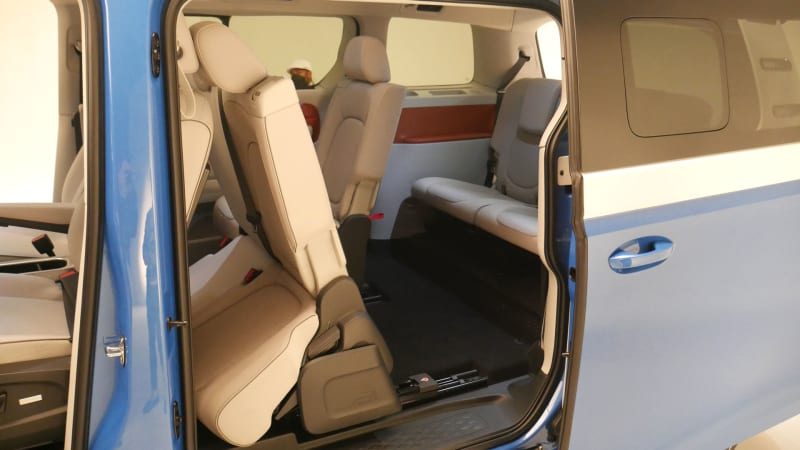
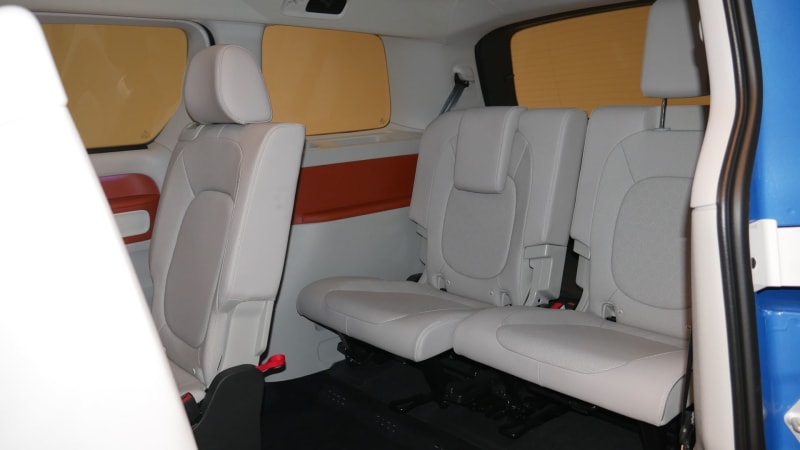
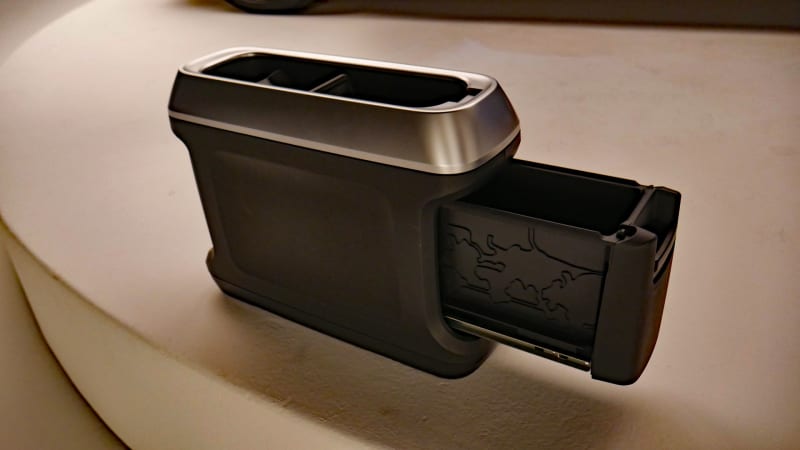
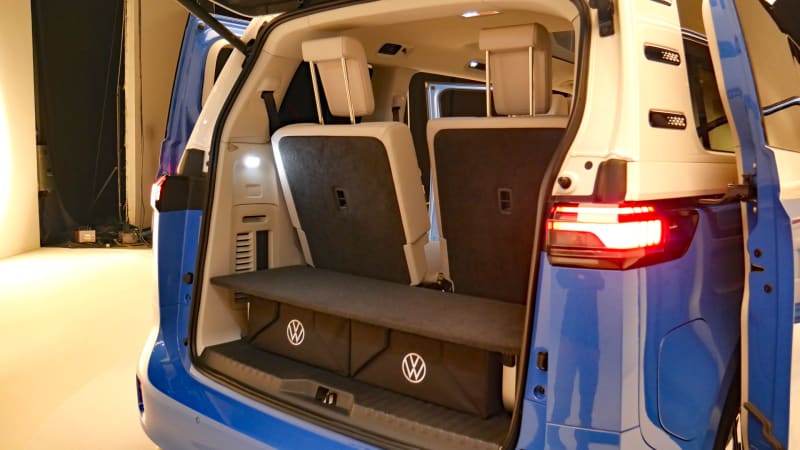
With a bigger van and a bigger continent with bigger performance and range expectations comes a significant increase in VW’s electric powertrain. Like the original VW Bus, the motor is in the back, which is a cute thing to point out, but then the standard two-wheel-drive layout of most electric vehicles sees the motor integrated within the rear axle. That’s the case with the smaller European ID. Buzz as well as the ID.4, both of which get a rear motor good for 201 horsepower and a rather paltry 229 pound-feet of torque. The North American, three-row ID. Buzz gets a new rear motor good for 282 hp and a substantially more robust 406 lb-ft of torque. This comes courtesy of stronger permanent magnets within the rotor, a new stator with a water-cooling jacket, and a revised oil-and-water cooling system. VW didn’t state a 0-to-60 time, but all that extra grunt should shave a good chunk off the Euro Buzz’s 10.2-second 0-100 km/h time even with the extra size.
Unlike that Euro Buzz, however, our three-row Buzz will get the option of a second motor placed on the front axle and therefore all-wheel drive. VW only stated it would produce “about 330 hp,” which is something, but far from the big-time jump you get with some other dual-motor EVs.
All that extra wheelbase isn’t just for interior space: It allows more real estate to stuff batteries. Capacity jumps from 82 kilowatt-hours in the Euro Buzz and ID.4, to 91 kWh. Expect range figures of about 260 miles with rear-wheel drive and about 250 with the dual motor. That’s only slightly less than the ID.4, which may have less battery capacity but is also smaller and less powerful.
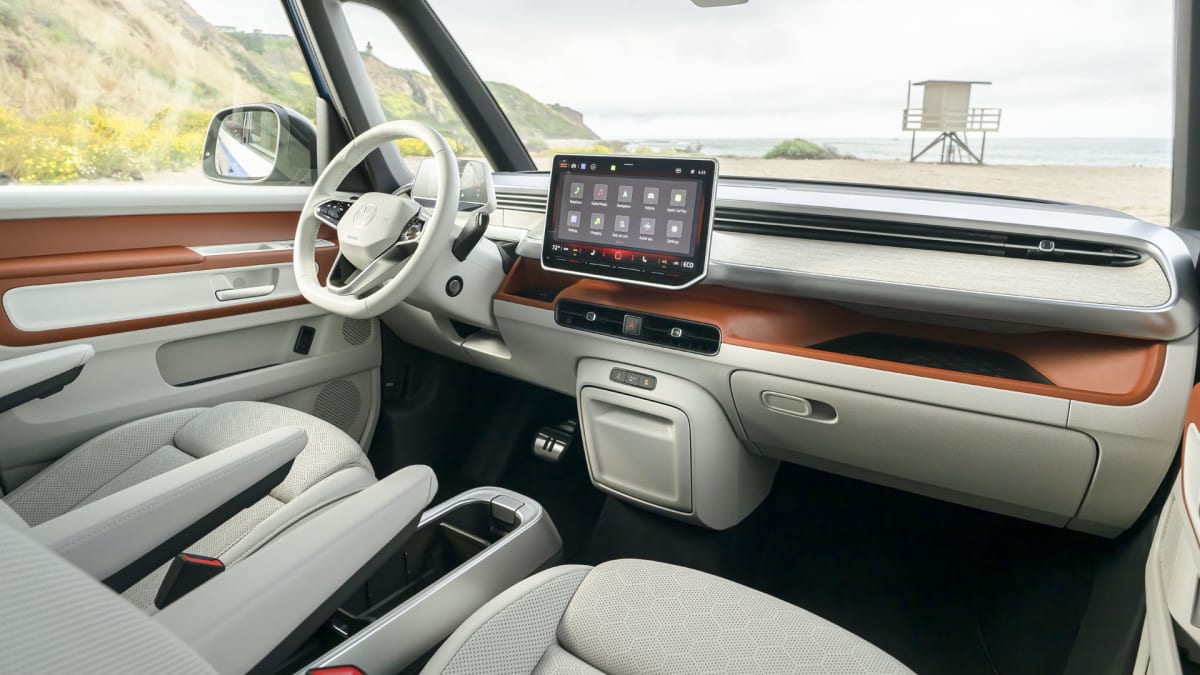
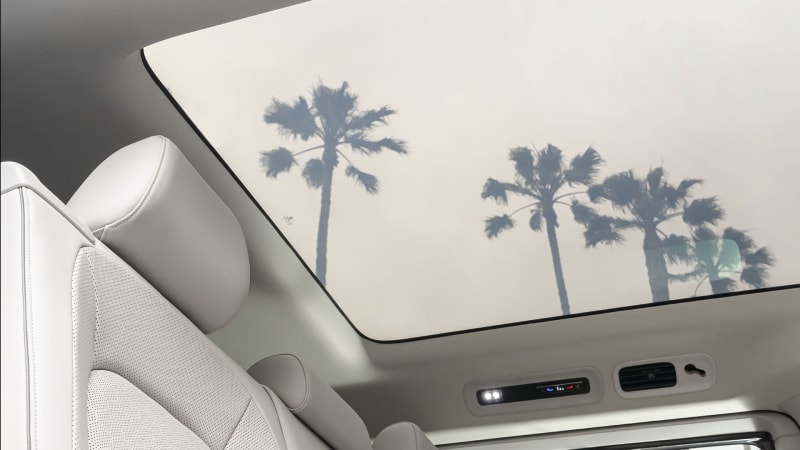
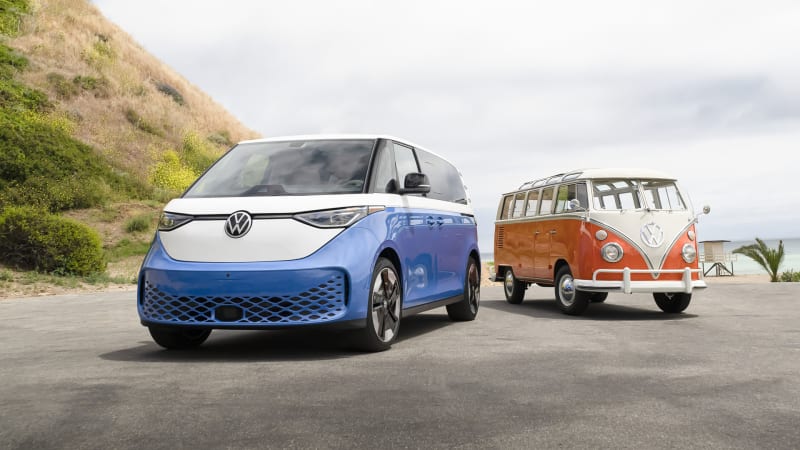
Apart from its extra space, the interior design carries over from the Euro Buzz, but you can forget about its vibrant yellow and orange choices. Boo. The light gray with orange-like “clay” accents is the most colorful it gets. The others are light brown seats with yellow piping, gray door inserts and a wood-look dash; or a dark brown and black combo with blue door inserts and wood-look dash. If I could add a gif to this story it would be Homer Simpson going “BORING!”
What it lacks in color, though, it will make up for in light. The available sunroof is 67.4 inches long and 40.8 inches wide, making it the biggest available in the Volkswagen Group. Remember, that includes Audi and Bentley. A polymer-dispersed liquid crystal layer changes the glass’ opacity rather than having a sunshade. Could get toasty, but let’s not forget the original VW Bus could have as many as 23 windows.
Another unique feature for the three-row model is the power-operated sliding window within the sliding door windows. Volkswagen touts this as a nod to the original bus, which I suppose it is, but really, it’s a necessity due to the desire to maintain flush-mounted side glass.
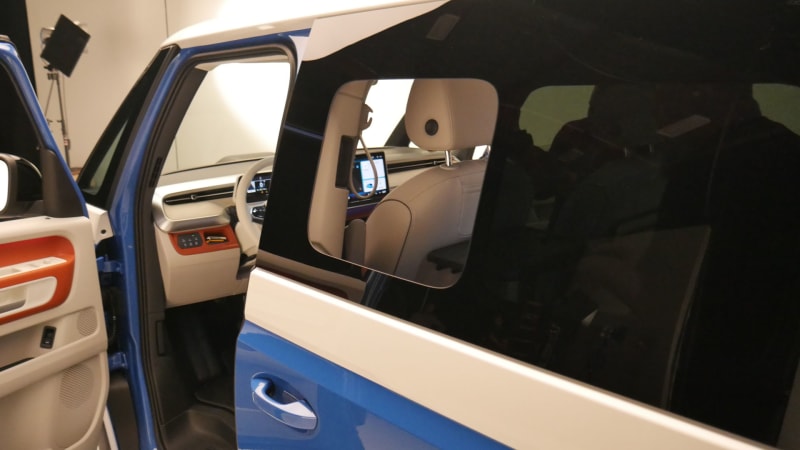
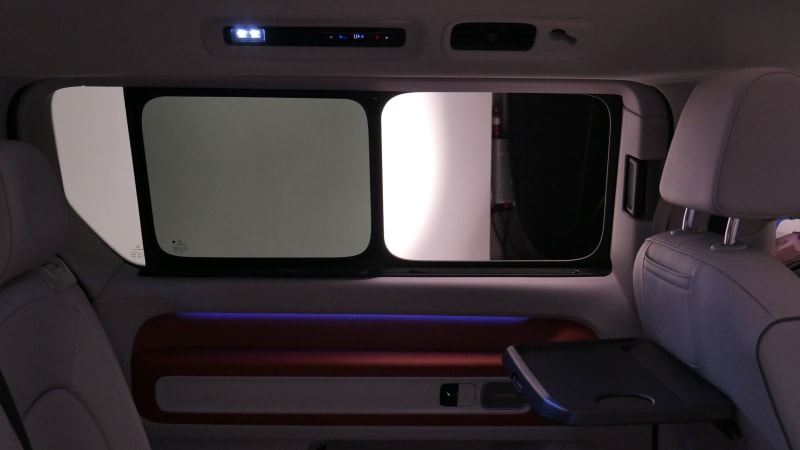
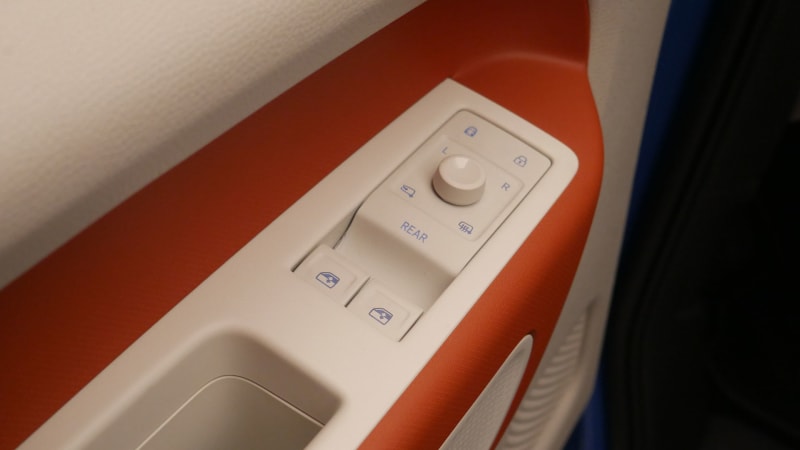
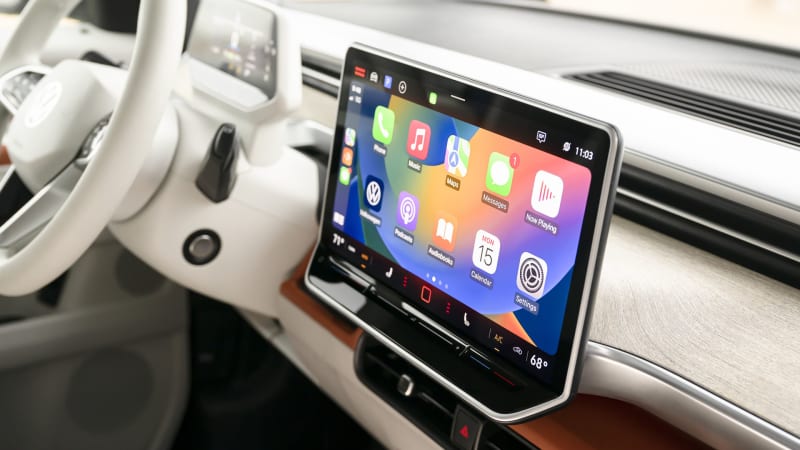
Like the upcoming ID.7, the North American Buzz gets an updated version of VW’s much-maligned (and rightfully so) touchscreen infotainment and vehicle control system. The touch sliders are now illuminated because everyone complained about that ridiculous omission. Climate functions are now docked at the bottom of the display. There are also a variety of other docked menu operations that should theoretically alleviate some of the system’s horrid functionality. Emphasis on theoretically. We’ll need to try out this updated system to know for sure.
Sadly, carried over unchanged from the ID.4 are the ridiculous window controls on the driver door (above, bottom left) that make you first press a touch-sensitive “rear” icon to switch the two window switches from controlling the front windows to controlling the rear sliders.
Pricing was not announced, but don’t count on a bargain. Besides being an electric, three-row vehicle with a whimsical design that’ll certainly command a premium, the Buzz doesn’t offer a bare-bones base model like the ID.4 does. The front seats are 12-way adjustable, heated, ventilated and massaging. The second row is heated, as is the steering wheel. Wireless charging, eight USB-C ports, and all the driver assistance features are included, too.
We should know that price as well as range closer to the on-sale date next year. Regardless of those details, though, we’re guessing you’ll want to get on the waiting list as soon as possible. The 2025 VW ID. Buzz seems like it’s going to be a hot ticket EV.
Related video:
